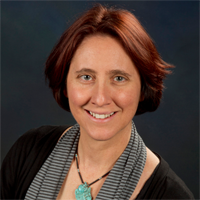
Jennifer A. Hollingsworth
Los Alamos National Laboratory
From Flask to Devices—The Making of Exceptionally Functional Colloidal Quantum Dot Emitters
Despite their humble origin, colloidal quantum dots (QDs) and other nanocrystalline semiconductors prepared in simple laboratory flasks are finding real-world applications in demanding technologies from displays and lighting to photovoltaics and photodetectors. In the future, they may be the basis for single-photon devices in quantum networks. Beyond quantum size control, we pursue an expanded “structural toolbox” to synthetically engineer this class of nanomaterial to realize specific novel and optimal photophysical properties.1-7 Here, I will describe our efforts to understand and control synthesis-nanostructure-properties relationships toward a materials-by-design approach to the next generation of useful semiconductor nanocrystals.8-10 Equally, I will describe efforts beyond synthesis to address the strict criteria for single-photon source applications through nanoplasmonics and nanophotonics integration.11-12
Jennifer A. Hollingsworth is a Laboratory Fellow at Los Alamos National Laboratory (LANL). She is a Fellow of the American Physical Society (Materials Physics) and the American Association for the Advancement of Science (Chemistry), and serves as an elected Councilor for the American Chemical Society Division of Colloid & Surface Chemistry. She holds a BA in Chemistry from Grinnell College and a PhD degree in Inorganic Chemistry from Washington University in St. Louis. She joined LANL as a Director’s Postdoctoral Fellow in 1999, becoming a staff scientist in 2001. In 2013, she was awarded the LANL Fellows’ Prize for Research for her discovery of non-blinking “giant” quantum dots. In her role as staff scientist in the Center for Integrated Nanotechnologies, a US-DOE Nanoscale Science Research Center and User Facility, she advances fundamental knowledge of optically active nanomaterials toward the rational design of novel ‘building-block’ nanomaterials, hybrid assemblies and functional devices.
References:
- S. Krishnamurthy, et al., ACS Nano 15 (2021), 575.
- J. R. McBride, et al., J. Chem. Phys. 152 (2020), 124713.
- A. M. Dennis, et al., Adv. Funct. Mater. 29 (2019), 1809111.
- C. J. Hanson, et al., J. Am. Chem. Soc.139 (2017), 11081.
- N. Mishra, et al., Nature Commun. 8 (2017), 15083.
- A. M. Dennis, et al., Nano Lett. 12 (2012), 5545.
- Y. Ghosh, et al., J. Am. Chem. Soc. 134 (2012), 9634.
- B. D. Mangum, et al., Nanoscale 6 (2014), 3712.
- N. J. Orfield, et al., ACS Nano 12 (2018), 4206.
- N. J. Orfield, et al., ACS Appl. Mater. Interfaces 12 (2020), 30695.
- H. Abudayyeh, et al., APL Photonics 6 (2021), 036109.
- E. A. Dolgopolova, et al., Nanoscale Horiz. 7 (2022), 267.